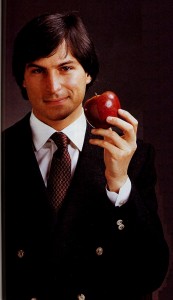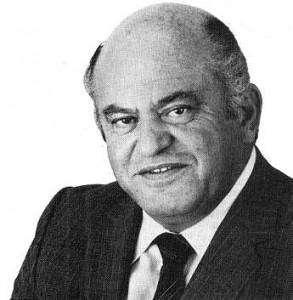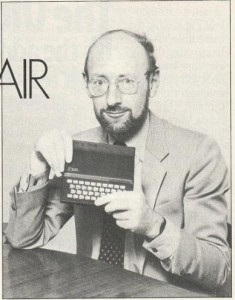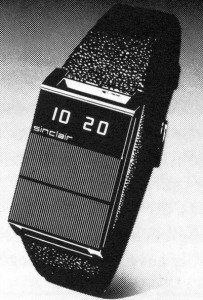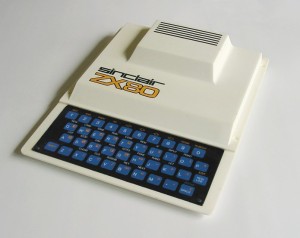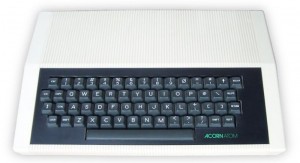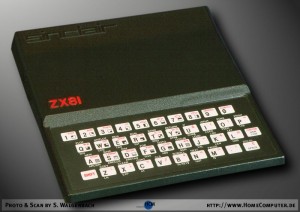For practical purposes, the British PC industry lagged about three years behind the American. It wasn’t that it was impossible to buy a modern American machine. Commodore alone sold some 45,000 PET systems in Britain in that platform’s first three years of availability, and, while they were less common, you could certainly buy imported TRS-80s, Apple IIs, and Atari 400s and 800s if you had the money. But it’s that last part that’s key here. At a time when the pound was worth around $2.50, even the most bare-bones PET system would set you back at least £650, while an Apple II system of the type that was pretty much the expected standard in America by 1981 — a II Plus with 48 K, a color monitor, two floppy drives, perhaps a printer — would quickly climb to around the £2000 mark. To fully understand just how out of reach these prices made computers for the average Briton, you have to understand something about life there in the late 1970s and early 1980s.
The British economy hadn’t really been good for quite some years, suffering along with the rest of country from a sort of general post-empire malaise punctuated by occasional embarrassing shocks like the Three-Day Week (1974), when chronic energy shortages forced the government to mandate that business could only open three days in the week, and the Winter of Discontent (1978-79), when strikes across a whole range of industries brought the economy and, indeed, daily life to a virtual standstill. The latter events were sufficient to ensure the election as Prime Minister of perhaps the most polarizing figure in postwar British political history, Margaret Thatcher, on a platform that promised to drag Britain into the modern age, if necessary kicking and screaming, by rolling back most of the welfare state that had been erected in the aftermath of World War II. Yet nothing got better in the immediate wake of Thatcher’s election. In fact, as the government imposed harsh austerity measures and much of the country’s remaining industrial base collapsed under privatization, they just continued to get worse. By 1981 unemployment was at 12.5%, entire cities were reduced to industrial wasteland, riots were becoming a daily reality, and Thatcher was beset by howling mobs virtually everywhere she went. It felt like something more than just a serious recession; it felt dangerous. That summer The Specials summed up the mood of the country in the apocalyptic, chart-topping “Ghost Town.” Things would get slowly, painfully better after that low point, but it would be nearly a decade before unemployment shrunk to reasonable levels and the modern economy Thatcher had promised really took hold with the beginning of the era of “cool Britannia.”
Suffice to say, then, that most Britons would not have been able to afford American computers even if they were priced in line with what Americans paid for them. While PETs were sold to businesses and TRS-80s and Apple IIs to the handful of wealthy eccentrics who could afford them, a parallel domestic industry arose to serve everyday users at prices they could afford. It began in 1978, three years after the Altair in North America, with a handful of do-it-yourself kits that let hobbyists solder together contraptions of toggle switches and blinking lights. The British equivalent of the trinity of 1977 then arrived, right on schedule, in 1980.
So many characters from the early PC era are larger than life, and their photos seem to say it all about them. You’ve got, for example, Steve Jobs, the glib, handsome charmer whom you wouldn’t quite trust with your daughter.
You’ve got Jack Tramiel, who (Jewishness aside) looks like he should be sitting behind a mound of spaghetti mumbling about breaking kneecaps.
And you’ve got the man history remembers as the first to bring affordable computers to the British public, Sir Clive Sinclair. He looks like a mad genius inventor who should be making gadgets for James Bond — or maybe Maxwell Smart. If you left him alone at your house you’d probably return to find the cat on fire and the daughter’s hair turned blue.
Despite having absolutely no formal training, Sinclair graduated from gigs writing for electronics magazines in 1961 to found Sinclair Radionics, a firm with the perfect name for a mad scientist’s workshop. After years spent selling kits for making radios, amplifiers, test equipment, and the like to hobbyists, Sinclair Radionics started a consumer-electronics line, for which, as (once again) befitted any proper mad scientist, they produced groundbreaking gadgets with absurd design flaws and about the worst quality control imaginable. There was the Sinclair Executive, one of the first calculators small enough to fit in a pocket, but which had an unfortunate tendency to explode (!) when left on too long. And there was the Microvision, a portable television. Unfortunately, Sinclair had neglected to ask just who the hell really wanted to watch TV on a 2″ black-and-white screen, and it was a commercial flop.
But the stereotypical — or satirical — Sinclair product was the Black Watch.
On the plus side, it was one of the first digital wristwatches. On the negative side — gee, where to start? The Black Watch was chronically unreliable in actually, you know, keeping time, never a good feature in a watch; it was apparently very susceptible to climate changes, running at different speeds in different seasons. Batteries lasted for a solid ten days if you were lucky, and were almost as hard to replace as the watch had been to assemble in the first place. (Like many Sinclair products, it was available as a do-it-yourself kit as well as in pre-assembled form). It had a tendency to literally fall to pieces all at once as the clips that held it together fatigued. But even that wasn’t the worst possible failure. In what was becoming a Sinclair trademark, the Black Watch was also known to explode without warning.
Released in late 1975, the Black Watch fiasco combined with the onslaught of cheap calculators from Japan marked the beginning of the end of Sinclair Radionics. Britain’s National Enterprise Board bought a majority interest in 1977, but quickly found Clive to be all but impossible to deal with, and found the hoped-for turnaround a tough nut to crack. The NEB finally pulled the plug on the company in the wake of Thatcher’s election; this sort of mixing with private business was of course under Thatcher’s new paradigm exactly what the government should not be doing. By that time Clive had already started another company on the sly to wriggle free of government interference with his management decisions. He named it Science of Cambridge to keep its guiding hand at least somewhat under wraps. This was the company that would start the PC boom in Britain.
For an exaggerated but entertaining picture of Clive Sinclair the man, I’ll point you to the show whose title I stole for this post, the BBC one-off Micro Men. He was a genuinely talented inventor with a flair for the art of the possible and a determination to bring out products at prices that ordinary people could afford — a populist in the best sense of the word. He was also stupefyingly stubborn and arrogant, one of those supremely tedious people who love to talk about their IQ scores. (He was chairman of British Mensa for almost two decades.) In a typical interview for Your Computer magazine in 1981, he said, “I make mistakes, everyone does, but I never make them twice.” Someone of more average intelligence — like for instance your humble blogger here — might beg to differ that his history of exploding products would seem to point to a man who kept making the same mistakes over and over, thinking he could avoid the perspiration of polishing and perfecting through the inspiration of his initial brilliant idea. But what do I know?
Sinclair had been involved with some of those blinking-box computer kits I mentioned earlier, but he first entered the computer market in a big way with the release of the ZX80 in early 1980, the £100 machine I mentioned in an earlier post as Jack Tramiel’s inspiration for the Commodore VIC-20. Indeed, there are some similarities between the two men, both egocentric executives who were forced out of the calculator market by the cheaper Japanese competition. Yet we shouldn’t push the comparison too far. Sinclair was, to use the British term, a thoroughgoing boffin, filled with childlike enthusiasm for gadgets and for technology’s social potential. Tramiel, however, was all businessman; he would, to paraphrase one of Steve Jobs’s most famous pitches, have been perfectly happy to sell sugared water for his entire life if that gave him the competition he craved.
The ZX80 was, once again, available as either a semi-assembled kit or, for somewhat more, a completed product ready to plug in and use. With its tiny case and its membrane keyboard, it looked more like a large calculator than a computer. Indeed, its 1 K of standard RAM meant that it wasn’t good for much more than adding numbers until the user sprang for an expansion. Its standard BASIC environment was bizarre and seemed almost willfully unfriendly, and it was beset by the usual Sinclair reliability problems, with overheating a particular concern. (At least there were no reports of exploding ZX80s…) The design was so minimal that it didn’t even have a video chip, but rather relied on the CPU to generate a video signal entirely in software. From this stemmed one of its most unique “features”: because the CPU could only generate video when it was not doing something else, the screen went blank whenever a program was actually running, even momentarily every time the user hit a key. But it was a real computer, the first really within reach for the majority of Britons. Sinclair sold 100,000 of them in less than eighteen months.
Science of Cambridge was not the only British company to make a splash in the burgeoning home-computer market in 1980. Another young company, Acorn Computers, released its own machine, the Acorn Atom, later that year.
The Atom cost about 50% more than the ZX80, but was still vastly less than any of the American machines. The extra money bought you a much more usable computer, with a proper keyboard, twice the RAM (even if 2 K was still sadly inadequate for actually doing much of anything), a display that didn’t flick on and off, and a less, shall we say, idiosyncratic interpretation of BASIC. The competition between Sinclair and Acorn was personal. The head of Acorn, Chris Curry, had been for some twelve years Clive Sinclair’s right-hand man. The two had parted ways in late 1978, ironically because Curry wanted to produce a new microcomputer that Sinclair did not (yet) see the potential of. Curry went on to form Acorn with a partner, Hermann Hauser, and barely a year later — Sinclair having suddenly gotten the microcomputer religion — was going toe to toe with his erstwhile boss and mentor.
The following year, 1981, would prove a pivotal one. Sinclair, who changed the name of his company that year to Sinclair Research in the wake of Sinclair Radionics dissolution, introduced the ZX81 in March, an evolution of the ZX80 design that further reduced the price to just £50 in kit form, £70 fully assembled.
Amongst other modest improvements, the ZX81 could run in “slow” mode, in which enough CPU time was always reserved to update the display, eliminating the screen blanking at the cost of dramatically slower CPU throughput. And it could handle floating-point numbers, an impossibility on the ZX80. Of course, it was also a Sinclair product, with everything that entailed. The 16 K RAM expansion didn’t quite fit into its socket correctly; it would occasionally fall out of place with disastrous results. Actually, most of the connections had similar if less acute problems, forcing one to tiptoe gingerly around the machine. (Presumably those living near train tracks were just out of luck.)
The Commodore VIC-20 also arrived that year, at an initial price of about £180. Very much a lowest end of low-end machines in North America, the VIC-20 with its 5 K of RAM and color graphics capabilities was considerably more capable than either the unexpanded Sinclair or Acorn; thus the comparatively high price.
In North America, we saw the emergence of a commercial software market in 1978, as hobbyists like Scott Adams began packaging their programs on cassette tapes in Ziploc baggies and selling them. True to the three-year rule, a domestic British software market began to emerge in 1981, with a similar do-it-yourself personality of hand-copied cassettes and improvised packaging. (One could hear the creators’ children playing and similar background noises on some of these “data” tapes.) Software of course largely meant games, and a big part of games was text adventures.
A very good candidate for the first homegrown British example of the form is Planet of Death, a game for the ZX80 and ZX81 released around June of 1981 by Artic Software, a company formed by two university students, Richard Turner and Chris Thornton, the year before. Unlike the earliest American text-adventure coders, Turner and Thornton had plenty of examples to follow, thanks to their Video Genie computer, a Hong Kong-manufactured clone of the TRS-80 Model 1 that became more popular than the real thing in Britain. (In fact, they did their coding on the Genie, which shared the Sinclair machines’ Zilog Z-80 processor, and transferred their work to the more primitive Sinclairs.) The Artic adventure line, of which Planet of Death was the first, shows a marked Scott Adams influence, from the instructions insert that calls the player’s avatar her “puppet” to Artic’s system of numbering its adventures to help the devoted assemble a complete collection. (One difference: Artic used letters instead of numbers. Thus Planet of Death is Adventure A.)
Planet of Death doesn’t cut a very inspiring figure as the first example of British ludic narrative. Mostly it makes you appreciate its inspiration; whatever his other failings, Scott Adams always finished his games before he released them. Planet of Death plays like something you might find sloshing around the bottom of one of the modern IF Competitions, albeit without the built-in technical competency modern IF languages like Inform bring to the table. It’s as if Turner and Thornton ran out of memory and simply stopped where they were — which, come to think of it, is likely exactly what happened. You’ve got bugs galore, a maze that’s doubly frustrating because it ultimately leads nowhere, red herrings and half-finished puzzles, all wired up to an unusually obtuse two-word parser that thinks “with” is a verb. Yet, just as the ZX80 and ZX81 were real computers, however limited an implementation thereof, Planet of Death was a real adventure game, the first most of the British public had seen, and it sold well enough to spawn a whole line from Artic. It stands at the origin of an adventure-game scene that would become if anything even more vital and prolific than that in the U.S. — one we’ll be following in later posts.
In an important signifier of the growing acceptance of PCs in Britain, the omnipresent High Street newsstand chain WH Smith began selling the ZX81 in its stores with the arrival of the 1981 holiday season, billing it as “your first step into personal computing.” Just as the arrival of the VIC-20 in K-Mart stores in North America signaled a similar paradigm shift there, mainstream British stores would soon be stocking not just Sinclairs but also Acorns and Commodores. Within a few years British computer sales would surpass those in the U.S. on a per capita basis, as Britain became the most computer-mad nation on Earth. We’ll get back to that. For next time, though, we’ll return to the U.S. to look at the last major computer introduction of 1981, and the most long-lived and important of all.
